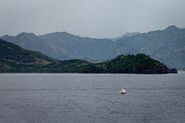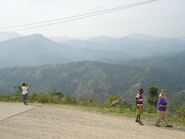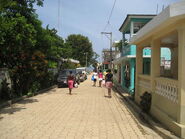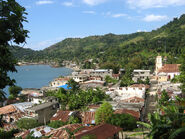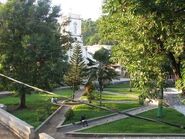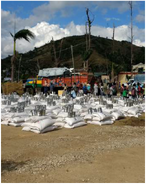Anse-d'Hainault (Kreyol: Ansdeno) is a commune located on the extreme western tip of Haiti's Tiburon Peninsula. Part of the Anse-d'Hainault Arrondissement in the Grand'Anse Department, the city has a low-density population of 30,000 residents and a low-humidity tropical climate. Its mineral-rich soil contains clay deposits, and its terrain is studded with farmlands and indigenous vegetation. As elsewhere in Haiti, Anse-d'Hainault is a predominately Catholic community.
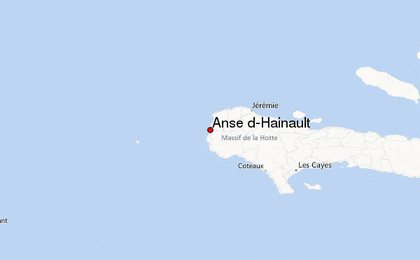
Location in Haiti
Etymolygy[]
This small town was named for its cove, which bears the name of the French settler Hainault or Eynault. His house was in the neighborhood, located some sixty kilometers (40 miles) from Jérémie, the metropolis of the Grand'Anse Department, and almost at the extreme tip of the Southern Peninsula. Its geographical location, its population, the beauty of its landscapes, and the abundance and diversity of its agricultural production, make it one of the most attractive cities of the Grand'Anse.
History[]
Moreau de St-Rémy traces the foundation of the city to 1798 during the evacuation of the English from Fort Îlet à Pierre Joseph. It has kept the name of the French settler's habitation who settled there thanks to the victory of the colonial army. But it was raised to the rank of commune in 1817 on the occasion of the official opening of its port to foreign trade.
• Jean-Baptiste Perrier, known as Goman, was the leader of the 2nd Battalion of the 19th half-Brigade confined to L'Anse d'Hainault. On the pretext that he was neither paid nor dressed, and profiting from the absence of the 18th half-Brigade of Jérémie who had left for Port-au-Prince in 1807 during the siege of this city by Christophe, he left the place of his cantonment to bring his batallion and lay his claim to Jérémie. But, knowing his indocile character, and especially his notorious history, the inhabitants of Jérémie greeted him with cannon blasts. Beaten, strung and discontented, Goman threw himself into the woods of Grande'Anse where he became the leader of a gang of brigands who had the greatest depredations in the countryside of Jérémie and in the settlements of the peripheral. For lieutenants, he had Jason Domingon, J.B. Lagarde, César Nouvelet, say Desormeaux, Saint-Louis Botteaux, among others. Christophe named Goman Comte de Jérémie. It was delivered in 1820 by Gilles Bénech after thirteen years of resistance, and was killed in the Anse Hainault heights.
• The law of April 25, 1817 and that of November, 20 1821 fixed its legal distance to the capital at 75 leagues.
• In 1892, the State gave 800 gourdes to repair the Church. It was allocated a sum of 4.000 gourdes to the budget of 1886-87 for the completion of the fountain, because one is obliged to fetch water at a quarter of League, and further in the drought.
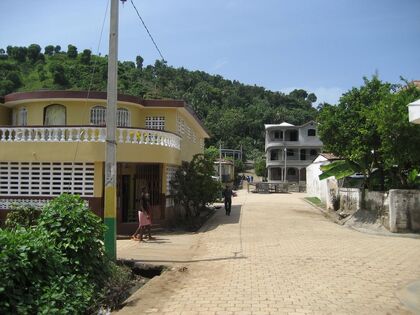
Anse-d'Hainault, Haiti
• On February 1st, 1843, General Lazarre, who commanded the borough, lifted the banner of the revolution, and joined the revolutionary parties of Praslin. At the head of the popular army, he went to Jérémie. In his absence, Colonel Cazeau des Cayes seized the village on February 6 for the Government of President Boyer. The citizens of Jérémie sent him a deputation to win him at the Revolution. He dismissed them by answering that he wished to follow the instructions of his Borough Commander, General Borgella, who commanded Les Cayes. However, being ready to be abandoned by his soldiers, Colonel Cazeau was soon obliged to leave L'Anse d'Hainault to get to Les Irois, and the people's army of Jérémie entered the village. Some of the citizens of the place were noted for their selflessness and their services. These were MESSRS. MM. Lebreton, Stanislas Tabuteau, Fourneaux Jeune, Mouras Père, Clette, Ismé Paret, Salès, Codiau, Bellefleur, and Jambon. The first had put his life and his fortune at stake. He paid from his funds the army at the time of his departure for Jérémie.
• Anse d'Hainault enjoyed an economic boom, especially during the 1940s, when trucks lined the roads in single file, carrying some twenty-two thousand (22,000) banana-fig loads from Standard Fruit and Steamship Company boats, came to embark at Anse d'Hainault. At that time, the money arrived every week without intermediary into the hands of the peasants. The excess loads that the boats could not carry were offered to the population. Everyone could help himself at will. At that time, the beggars did not even have to reach out to passers-by, but instead were invited to free feasts. They could eat either at Standard Fruit sheds or at public markets where unsold food (real trees, avocados, bananas, etc.) were left behind.
• Anse d'Hainault was the scene of bloody clashes during the revolution of the Cacos in 1869. The stakes succeeded in seizing the Cacos, and were definitively hunted only in March 1870, three months after the triumph of the revolution and the execution of President Salnave in Port-au-Prince.
Geography[]
Anse-d'Hainault has four communal sections, Two of these communal sections, Grandoit and Boudon are regarded as interior zones while the other communal sections and the city center of Anse-d'Hainault are coastal. The Îlet River is a good fresh water bath.
The dominant relief of the first three communal sections are hills; the city's center and the fourth section are mostly flat land. Depending on the period, the temperature of the town of Anse-d'Hainault is either hot or normal. Its inhabitants bear the name of Anselais or Hainaudin.
| Year | Population | Change |
|---|---|---|
| 1890 | 12,000 | |
| 1950 | 13,020 | +9% |
| 1971 | 14,539 | 12% |
| 1982 | 20,575 | +42% |
| 1998 | 30,549 | +48% |
| 2003 | 23,185 | -24% |
| 2009 | 33,103 | +43% |
| 2015 | 36,401 | +10% |
Economy[]
Due to its proximity to the sea, fishing is among the main economic activities of the municipality. Agriculture, trade, and crafts are the other principal economic activities. The inhabitants of the town trade with the municipalities of Les Irois and Dame-Marie. Its outlets are Jérémie and Port-au-Prince.
The commune produces coffee, cocoa, Campeche, bamboo, shipbuilding timber, and an abundance of food, fruits, and pickles. The campeches are shipped to Europe and especially to the United States. There are traces of copper mines. Mineral waters, red ochres, copper ores, marble, silex, and flint.
As for the economic and financial infrastructures, the commune is very poorly endowed. There is a hotel and five restaurants.
Market day is Saturday. The main markets in town are Boudon in the 2nd section and Marche Gabriel in the 3rd section.
Modernization of fishing industry
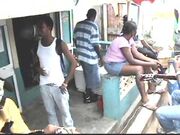
Anse d'Hainault
Infrastructure[]
Anse d'Hainault has many advantages to its development. But hatching is slow to occur.
Transportation Anse-d'Hainault is on the Route Departmentale 702 roadway, on the stretch of road positioned between Jérémie and Les Anglais.
Education
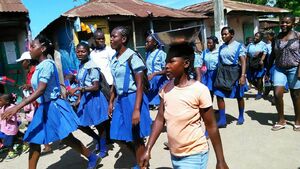
Anse d'Hainault schoolchildren
The Ministry of National Education of Youth and Sports is represented in the municipality by a school inspection office. Two kindergarten, fourteen primary schools of which seven public, five private and two congregational have been listed in the municipality. At secondary level, three schools, one public and two private, have been identified in the commune. Among them a high school that offers courses until rhetoric. There are also two Literacy Centers and four Technical and Vocational Schools. There is no university in the town of Anse-d'Hainault.
Health
In the field of health, the Ministry of Public Health and Population is not represented in the commune. Two public hospitals and one private clinic were inventoried with three doctors, one dentist, two nurses and eight auxiliaries.
Utilities
The town of Anse-d'Hainault has four rivers, six springs and one pond. There are also twenty wells and seven public fountains. Many sources water the habitations from the interior. Only the city [center] of Anse-d'Hainault is electrified by Electricity D'Haiti (EDH). The feeding frequency is 42 hours per week.
Security
On the side of the administrative and judicial infrastructure, two peace courts, a prison, a registry office and a police station with eight policemen were listed in the municipality. The garrison consists of the 19th line infantry regiment, half of the 2nd Battalion of the 2nd line artillery regiment, an administrative police company, the rural police, and the National Guard on foot and on horseback. The 19th Regiment stood out in front of Jacmel in 1888 in the Merisier case.
The Court of peace of L'Anse Hainault falls under the jurisdiction of the Civil Court of Jérémie. The schools of the municipality are under the Tiburon district.
Culture[]
Religion
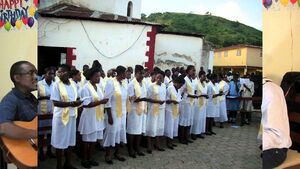
Anse d'Hainault Fest
On the religious side, the town of Anse-d'Hainault has five Catholic churches (including chapels), four Baptist churches, three Adventist churches, six Pentcostal churches and two Kingdom Halls of Jehovah's Witnesses.
The lodge of L'Anse d'Hainault is The improvement of the morals No.14, falling under the Grand Orient of Haiti.
Holy Trinity Catholic Church
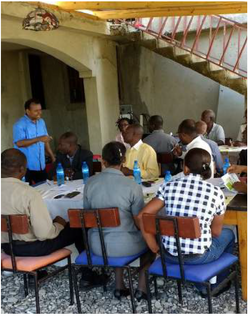
Town meeting in Anse d'Hainault
When the 7.0 magnitude 2010 earthquake shook Port-au-Prince and other regions in the country to their foundations, emotional shock waves reverberated throughout the world. In the aftermath of the cataclysmic event, no place has had a stronger response and made a fuller commitment to Haiti than Holy Trinity Catholic Church (HTCC).
HTCC is located in Washington D.C., where they recently held their Third Annual Haiti Committee Dinner to educate their parishioners about the Haitian people's unquenchable spirit and resolve to move forward despite incalculable set-backs arising from the earthquake. Describing and showing how the Haitian people have bounced back from the shattering event that leveled their country's infrastructure.
Communication
The town has a telephone call center which contains four cabins of which three are functional. There is no postal office, newspaper / magazine and television station in the municipality. However, there are two radio stations. [2]
The post, comimg from Abricots, Jérémie, Port-au-Prince and points north, arrives on Tuesday evening, and leaves the following Monday for the same destinations by a courier on foot, and for Tiburon and the rest of the south by another courier, from post to post.
Leisure
As for Leisure, three libraries, one cinema room (video system), and a theater room (the parish hall) were counted in the town of Anse-d'Hainault. Sports practiced include football, volleyball, basketball, athletics and cycling.
The town does not have monuments or historical sites. Its patron saint is Saint John the Baptist, celebrated on June 24 of each year.
The commune does not have political parties. There were two grassroots organizations and two international organizations.
Anse-D'Hainault, Haiti
Geography[]
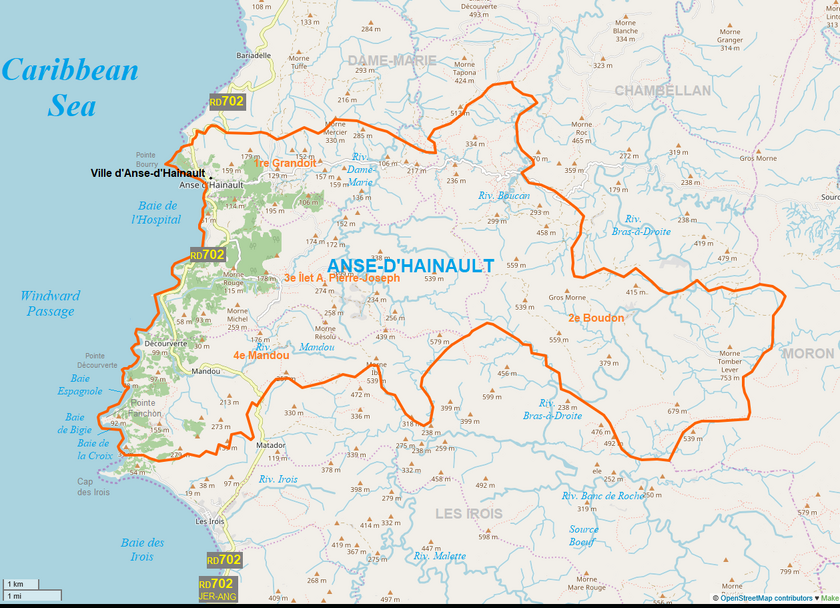
Commune map of Anse-d'Hainault, Haiti.
Neighborhoods[]
| ADH | Anse-d'Hainault | 36,401 | |||
|---|---|---|---|---|---|
| VAH | Ville d'Anse-d'Hainault | Urban | 14,030 | ||
| GDO | 1ère Section Grandoit | Rural section | 3,166 | Déjac, Franklin, Grandois, Haut-Jonc, Lumette, Nan Six, Péligrin, Sarc, Soulé. | |
| BDO | 2ème Section Boudon | Rural | 7,291 | Calumette, Decotelette, Gros-Morne, Nan Baid, Nan Roche, Noel, Sicard, Tapona, Vincent. | |
| IPJ | 3ème Section Îlet à Pierre Joseph | Rural | 8,162 | Boyer, Casal, Durocher, Escamel, Gabriel, Leblanc, Lezinc, Malette, Nan Georges, Nan Maçon, Nan Mala, Paraclet, Roban. | |
| MDO | 4ème Section Mandou | Rural | 3,752 | Basié, Bernard, Découverte, Dossous, Mandou, Perroquet. |
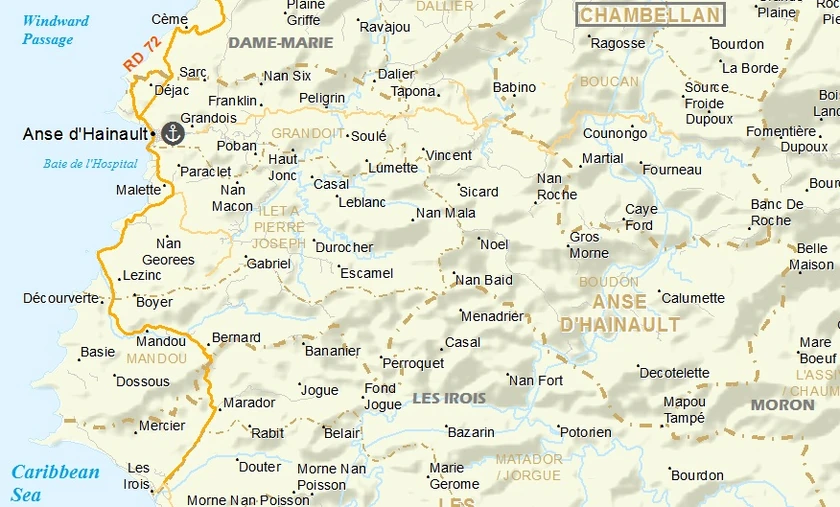
References[]
Anse d'Hainault [3]
Boroughs and municipalities: Grande-Anse [4]
Michael Vedrine


